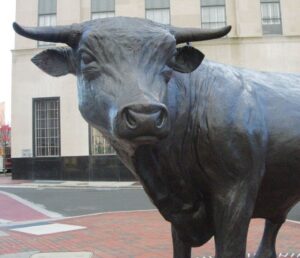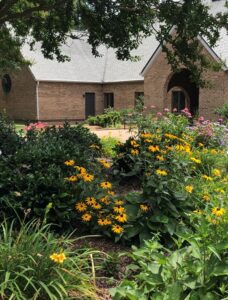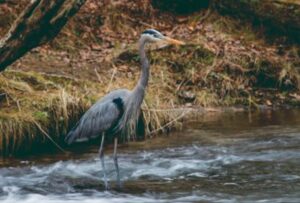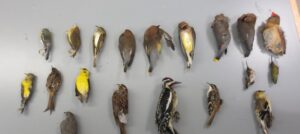Durham Is for the Birds!
Working toward a Community
Bird-friendly Designation
by Lynn Richardson
New Hope Audubon’s Bird-friendly Habitat Committee is embarking on an exciting and ambitious project with Durham city and county — designating the community as bird friendly. The city/county Environmental Affairs Board gave a resounding thumbs up to the plan at their September 2019 meeting. Mayor Steve Schewel and county commission chair Wendy Jacobs expressed their enthusiasm at a meeting in October of this year and opened the door for us to work with the planning department, Durham County Cooperative Extension, and others.
 Major the Bull, symbol of Durham.
Major the Bull, symbol of Durham. The human-dominated landscape of our towns and cities no longer supports functioning ecosystems or provides healthy places for birds. As more and more land is developed to accommodate the ever increasing number of people, reestablishing the ecological functions of urban areas is essential for the birds, other wildlife, and for us. Urbanization has fragmented ecologically productive land with deserts of sterile lawns and non-native plants; it has introduced walls of glass, toxic pesticides, and brightly lit night skies. With nearly three billion birds lost since 1970, it’s time for change!
The team working on this effort has established criteria for achieving designation. These criteria fall into three categories:
Category 1: Habitat Creation, Protection, and Monitoring
A. Use native plants.
B. Eliminate invasive plants.
 Pollinator garden at Durham’s Triangle Grace Church.
Pollinator garden at Durham’s Triangle Grace Church. As all good Audubon-ers know, native plants are essential for birds to thrive and to feed their young. Invasive plants, on the other hand, displace native plants and don’t provide the nutritious food birds need. Audubon is asking that Durham mandate, where possible, and otherwise strongly encourage landscaping with native plants and elimination of invasive plants through a combination of ordinances, resolutions, and public education. We’re asking that the city and county make a special effort to plant more native trees, which are especially valuable to birds, and promote planting of pollinator gardens composed of native plants.
C. Protect wetlands, stream and river buffers, open spaces, and wildlife corridors.
Wetlands and stream and river buffers provide breeding grounds, migration stop-overs, and year-round habitat for many bird species. These areas also help control storm-water runoff, protecting water quality of rivers and lakes that are breeding grounds for birds such as ospreys and eagles. Birds need contiguous, high-quality habitat to live and have enough food to raise their young. Birds and other wildlife do not thrive when habitats are fragmented. We’ll be asking that existing wetlands and stream buffers be protected and new buffers and managed wetlands be created to control storm water runoff where feasible, especially in new developments. We will also encourage protection of more open space and wildlife corridors to create contiguous habitat birds and other wildlife need.
 Ellerbe Creek Watershed Assoc’s urban Pearl Mill Preserve.
Ellerbe Creek Watershed Assoc’s urban Pearl Mill Preserve. D. Promote healthy bird habitat.
We will encourage efforts to minimize turf and to “leave the leaves” to nurture insects and provide soil nutrients. Leaves, widely considered to be waste, are actually a vital component of a healthy ecosystem. We will work toward more nesting habitat for breeding birds. Given Durham’s large population of chimney swifts, a special effort will be made to protect their existing roosts and promote creation of more.
Category 2: Limiting Threats to Birds
A. Reduce or eliminate use of pesticides.
Rat poisons, weed killers, insecticides—birds are no match for these insidious products. We will ask relevant city and county departments to adopt an integrated pest management approach to deal with flora and fauna considered problematic. The American Bird Conservancy says that, “Aside from our ethical commitment to conserve birds, they provide billions of dollars’ worth of insect and rodent control, plant pollination, and seed dispersal. Some studies are finding that pesticides actually reduce agricultural yields by decimating the birds, bats, butterflies, and beneficial invertebrates that keep pests in check.”
B. Prevent bird-window collisions.
 Victims of window collisions at Duke University
Victims of window collisions at Duke University Collisions with glass kill up to a billion birds per year in the United States, according to the American Bird Conservancy. We will ask the city and county to reduce bird/window collisions in public buildings using films or other techniques to make windows visible to birds. (These products don’t interfere with good visibility for people.) We will also evaluate bird-friendly building standards for new public buildings. Public education efforts will also encourage residents to bird proof their windows.
C. Implement a “lights out” program and reduce light pollution.
Billions of birds that migrate by night are disoriented by bright city lights. Some collide with buildings; others become exhausted trying to find their way. We will ask Durham to implement a “lights out” program in buildings during spring and fall migration. We will also verify that current outdoor lighting sends light to the ground where it is needed, not into the sky.
Category 3: Public Engagement on Topics in Categories 1 and 2
It is important that the entire community becomes involved with this important project. City and county government, Audubon, and our partners will engage, educate, and inform people throughout the city and county to encourage them to adopt these criteria. We will make a special effort to reach traditionally underserved people. Assuming success in Durham, we plan to reach out to other towns in New Hope Audubon territory to help them work toward bird-friendly designation. Ideally, we’ll end up with a program that other chapters across North Carolina can replicate.
Interested in pursuing bird-friendly community designation for your town in the New Hope Audubon area of Orange, Durham, Chatham, and parts of surrounding counties in North Carolina? Please use the contact form on our website or email us at [email protected].
Photo credits:
Major the Bull, symbol of Durham. https://durhamnc.gov/3245/Public-Art-Collection
Pollinator garden at Durham’s Triangle Grace Church. – photo Lynn Richardson
Ellerbe Creek Watershed Assoc’s urban Pearl Mill Preserve. – courtesy ECWA https://www.ellerbecreek.org/pearl-mill.html